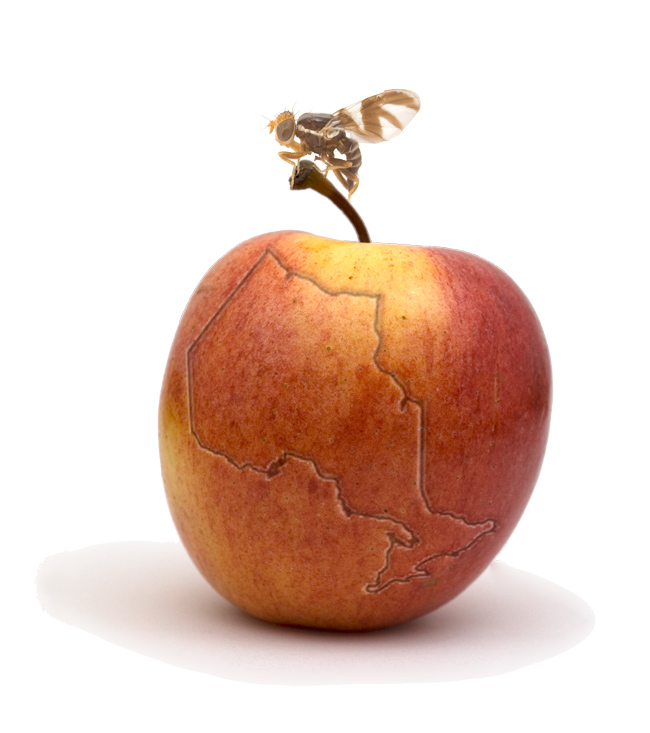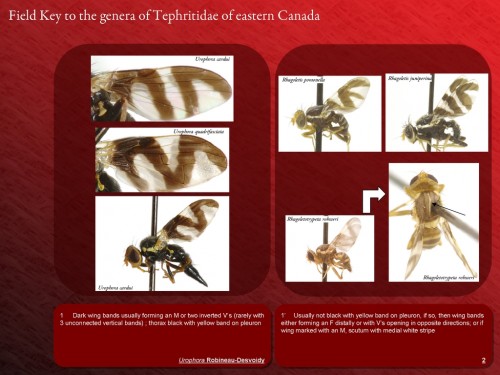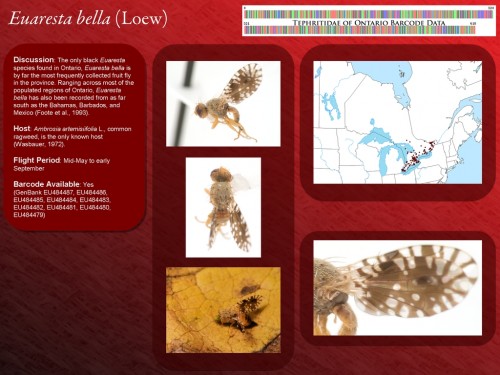Normally I’m pretty excited to see a new identification guide published in the Canadian Journal of Arthropod Identification; I get to see great images of insects I haven’t come across (yet), ID any of my photos which I couldn’t previously, and just have something new to read that I find especially interesting. The most recent publication is a little more exciting for me however, as I’m the lead author and it marks the culmination of several years work! W00t!
Without further ado, I present to you the Fruit Flies (Tephritidae) of Ontario! I’ll be going over the different aspects of the paper all this week; today focusing on the identification tools, Wednesday on a few of the important species, and Friday I’ll talk about how it’s relatively easy to contribute to CJAI!
 While not as well known as their similarly-named cousins, fruit flies in the family Tephritidae are an extremely important group of flies. Some species are pests on the fruits we eat and flowers we cultivate, while others are used to fight invasive weeds. Rhagoletis pomonella is a model organism for studying evolution and speciation, and related species have been found to mimic their predators to escape certain death. From a scientist’s perspective there are plenty of reasons to study fruit flies, and with their bright colours and intricate wing patterning, many naturalists and photographers have been drawn to them as well. While there are some relatively recent identification tools out there, they either include a broad selection of species covering a large geographic area (making them complicated and difficult to use), are technologically obsolete and/or are unavailable to the general public, essentially making the identification of these engaging flies out of reach for most people.
While not as well known as their similarly-named cousins, fruit flies in the family Tephritidae are an extremely important group of flies. Some species are pests on the fruits we eat and flowers we cultivate, while others are used to fight invasive weeds. Rhagoletis pomonella is a model organism for studying evolution and speciation, and related species have been found to mimic their predators to escape certain death. From a scientist’s perspective there are plenty of reasons to study fruit flies, and with their bright colours and intricate wing patterning, many naturalists and photographers have been drawn to them as well. While there are some relatively recent identification tools out there, they either include a broad selection of species covering a large geographic area (making them complicated and difficult to use), are technologically obsolete and/or are unavailable to the general public, essentially making the identification of these engaging flies out of reach for most people.
This new paper provides not only a technical key to the genera of eastern Canada (and neighbouring US states), but also what I’ve termed a “field key”. This field key was designed to simplify the identification of adult fruit flies by using characters like wing patterns and body colours, which are easily visible in a macro photograph of even modest magnification. The technical key uses a broader array of characters (like bristles and wing veins) in case you’re trying to identify an incomplete specimen (old museum specimens, flies damaged in traps, etc) which may be missing wings. Of course both generic keys are heavily illustrated, and I’ve included morphological diagrams and a glossary to point novice entomologists in the right direction.
Each genus also has a key to species for the Ontario fauna. Of the 31 genera we’re recording from Ontario, 23 have only a single species or species which are very easily identified, making a species identification very probable for photographs. The remaining 8 genera will require closer examination of the specimen (either with a hand lens or microscope), but I’ve tried to keep the keys as simple as possible. In addition to the keys, each species found in Ontario has photographs of the wing, dorsal and lateral habitus, a range map compiled from specimens in each of the major Ontario insect collections, and a summary of known host plants.
Finally, imagine you’re in charge of inspecting fruits and other plant matter at an international border, and a shipment arrives carrying some small white maggots along with the intended cargo. Identifying larvae is not nearly as straightforward as adults, and sending specimens off to an expert can result in the shipment going bad while you’re waiting. With this in mind, we gathered COI sequences (DNA Barcodes) for 41 of the 73 species found in Ontario. This will hopefully allow larvae to be identified quickly and easily in the future, and reduce the amount of wasted produce at borders.
Hopefully the tools included will allow anyone to identify all manner of specimen, whether adult, larval, or digital! Sometimes the species found can be quite surprising, but we’ll wait for Wednesday for that!



Admirable!
Morgan, you have made my life slightly easy! I see lots of Tephritids around in India, and I’m sure this paper will be useful in someway! Congratulations on this piece of science (and art, for the photography)! 😀
It will hopefully give you a starting place for your Indian tephritids at least, although I have no clue what sort of fantastic fruit flies you’ll come across there! Can’t wait to see photos of some!
Awesome- congrats! Will your key work for the midwestern US, too?
Thanks Alex, the generic key should work well for your area, as will most of the species keys. You might get the occasional species in Illinois which won’t be represented here, but the majority should key out fine I think!
I love that image at the top!
Congratulations, Morgan! It looks very well done.